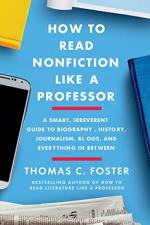
|
| Name: _________________________ | Period: ___________________ |
This quiz consists of 5 multiple choice and 5 short answer questions through Section 4: Chapter 13,"On the Stump" through Chapter 15, "Reading Internet Sources".
Multiple Choice Questions
1. In Chapter 10, "From the Inside Out," what important characteristic of the essay does Foster point out?
(a) It is an ancient form of writing.
(b) It teaches the reader to organize their thoughts.
(c) It is highly adaptable.
(d) It is more easily understood than other forms of nonfiction.
2. In Chapter 13, "On the Stump," Foster says that Omarosa "uses her first name mononymously" (188). What does this mean about her use of her first name?
(a) She uses a nickname as her first name, but it is not her legal first name.
(b) She uses it alone, as a one-word name, without her last name.
(c) She uses it for professional work, but it is not her real first name.
(d) She uses her last (family) name as her first (personal) name.
3. In Chapter 7, "All in How You Look at Things," what does Foster cite as one of the main reasons that Americans have historically trusted the news media?
(a) The strict editorial control of content.
(b) Journalists' willingness to admit mistakes.
(c) The tendency of editors to insist on multiple sources.
(d) Journalists' willingness to admit bias.
4. In Chapter 6, "Source Code,"what does Foster say about researching primary sources on microfiche?
(a) It's too much work.
(b) Microfiche is an unreliable medium.
(c) Microfiche is obsolete and has already been supplanted by digital sources.
(d) It may be tedious, but it's worth the effort.
5. In Chapter 7, "All in How You Look at Things," what does Foster say the term "Fake News" originally referred to?
(a) Online sources of maliciously false news.
(b) News the reader dislikes.
(c) News that powerful politicians dislike.
(d) Tabloid content.
Short Answer Questions
1. In Chapter 7, "All in How You Look at Things," what does Foster say is the purpose of the academic five-paragraph essay?
2. In Chapter 5, "It May Just Be Me, But..." what kind of person does Foster say is likely to be biased?
3. Using an argument like "Democrats just want to take your guns" in an address to a gun rights organization in a heavily Republican area would be an example of which flaw in argumentation?
4. In "Interrogating the Text," where does Foster say the "three questions" originate?
5. In Chapter 15, "Reading Internet Sources," Foster cites Wikipedia as the source of his information about the development of the internet. What might we reasonably call his use of Wikipedia as a source?
|
This section contains 458 words (approx. 2 pages at 300 words per page) |

|




